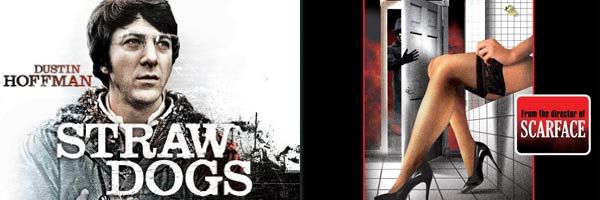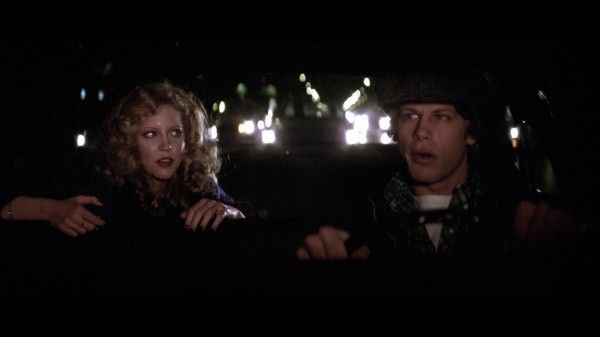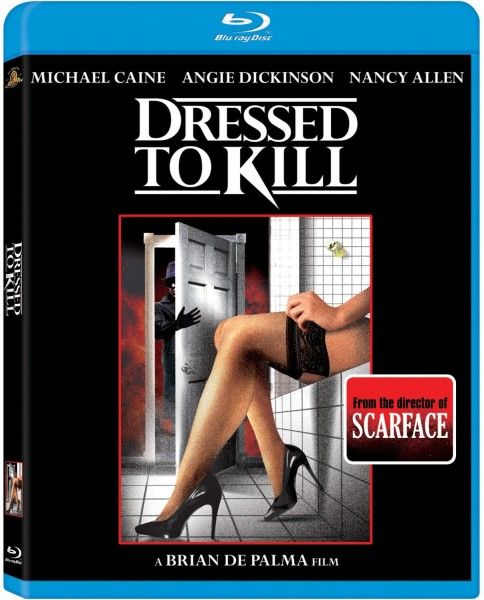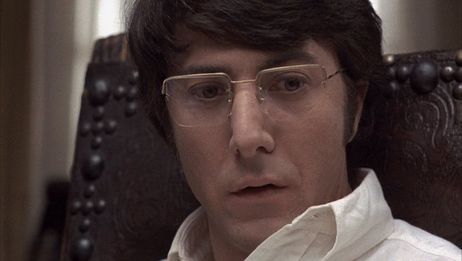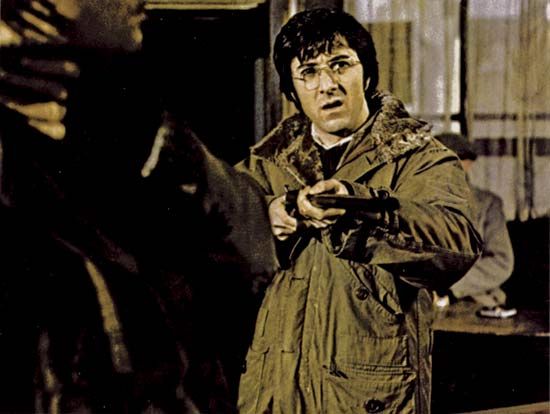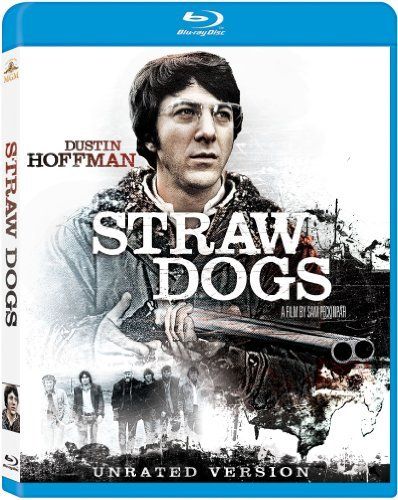Two masters have had two of their great works hit Blu-ray. Both are tie-in releases. Brian De Palma’s Dressed to Kill – which stars Angie Dickenson, Michael Caine and Nancy Allen - is hitting because Scarface is also hitting Blu-ray. Sam Peckinpah’s Straw Dogs – Starring Dustin Hoffman and Susan George - has been released in conjunction with the remake. These discs don’t offer much reason for upgrade unless you want 1080P picture quality, but both are essential viewing. Our reviews of both follow after the jump.
When you talk about Dressed to Kill, it’s going to lead to talk of Alfred Hitchcock, and that’s because – though Brian De Palma may have started his career directing comedies - he's obviously a student of Hitchcock. Making films that feel Hitchcockian has been De Palma’s modus operandi since 1973's Sisters. But then again, alongside such notable colleagues as Martin Scorsese, George Lucas, and Steven Spielberg, De Palma was one of the first of the "film school" filmmakers — directors who learned their craft from watching movies, and who made no attempt to hide their influences. Lucas has been filming under the influence of Kurosawa for much of his career, and De Palma has surveyed such predecessors as the Odessa Steps sequence from Eisenstein's Potemkin and Dassin's silent heist in Rififi. And with 1980's Dressed to Kill he pays homage to Psycho, much as in 1976's Obsession he did to Vertigo.
Angie Dickinson stars in the Janet Leigh-esque role as Kate Miller, a lonely mother trying to deal with her frustrations because her husband doesn't take care of her (cough) needs, and while her shrink Dr. Robert Elliott (Michael Caine) tells her to address the issue with her husband, all she wants is a good “no questions asked” ride in the sack. Once she gets what she needs from a man with VD (in a bravura dialogue-free sequence through an art museum) , Kate is murdered by a mysterious woman. And then the woman drops her incriminating razor-blade at the feet of Liz Blake (Nancy Allen), an uptown prostitute who's only interested in the stock market. Brought in by the police for questioning, Liz meets Kate's science-geek son Peter (Keith Gordon), who figures - after eavesdropping on Dr. Elliott's interrogation - that the killer must be one of the doctor's patients. Peter photographs Elliott's clientele and shows Liz his findings, but both realize that the killer is now after her, while the cops want to toss Liz in the klink unless she leads them to the killer.
Dressed to Kill's various borrowings from Psycho include (but are not limited to) the killing of the lead early in the piece, the killer's "trick" identity and subsequent explanation, and much of the music (Pino Donaggio's score has a strong Bernard Herman flavor) - making it easy to dismiss De Palma as a rip-off artist better at mimicry than developing his own voice. But that does not acknowledge the tremendous talent it takes to do what De Palma does here, and does well. Just compare Dressed to Kill to Gus Van Sant's 1998's remake of Psycho. Where Van Sant tried to completely copy a Hitchcockian masterwork, winding up with less-than-inspired results, De Palma employs the "riffing" of a great jazz musician. And like John Coltrane's version of My Favorite Things, De Palma never planned on a remake, but instead took a feel and a form to interpret for himself. Though heavily indebted to Hitchcock, De Palma has tricks of his own, and one must admire the craft of taking old ideas and reinventing them anew. Dressed to Kill is thrilling, and at times ingenious. De Palma has a surgeon's precision at wringing optimal pleasure out of the film's most suspenseful moments, and he really understands how entertaining it is to observe people in peril.
Fox/MGM's Dressed to Kill blu-ray is presented in widescreen (2.35:1) in the uncut version and in DTS-HD 5.1 surround. I have to say I’m very impressed with the transfer, which manages to have a very filmic feel to it, while still offering the clarity one hopes for from a Blu-ray release. Bonuses include a documentary called “The Making of a Thriller” (44 min.) featuring interviews with De Palma, producer George Litto, Allen, Dickinson, Gordon, Allen, and Dennis Franz, among others and three featurettes — a comparison of the R, unrated, and TV versions of the film (5 min.) a look at how much trouble the film earned with the MPAA called “Slashing Dressed to Kill” (10 min.) and an appreciation by Keith Gordon (6 min.). Also on board are the theatrical trailer and a still gallery (6 min.) covering on-set.
Sam Peckinpah's 1971 film Straw Dogs opens with Susan George’s character walking around bra-less. It's somewhat shocking, feasibly erotic, and inarguably provocative. Is she a sex object, a tease, or merely cold? All we know is that she is quite obviously bra-less and married to David Sumner (Dustin Hoffman). Straw Dogs takes audiences places where they would not feel comfortable.
Straw Dogs felt the heat of that discomfort when it was released. It was trimmed to get an R rating, was banned in England for 30 years, and Pauline Kael called it "the first American film that is a fascist piece of art." This is due not only to the subject matter of the piece, but because of two key scenes, one featuring rape (or violent sex) and the other featuring murder (or justifiable homicide), depending on how we look at it.
Straw Dogs follows David and Amy Sumner as they relocate to a small Cornish village - where Amy grew up - so David can research experimental mathematics. Upon their arrival, Amy runs into Charlie Venner (Del Tenney), whom she used to date. Though Amy feels at home, David is out of place among the more masculine men in town, in particular local trouble-maker Tom Hedden (Peter Vaughan). He also finds it hard to address things that bother him — like how long it's taking Norman Scutt (Ken Hutchinson) to finish the garage roof. And when David and Amy are alone together, it's obvious that their marriage is not healthy. He doesn't respect her intelligence and often exhibits passive-aggressive behavior with her (and others, like Scutt). When Amy wants to have sex, David finds himself easily distracted.
Noting that Venner has an interest in his wife, it seems odd that David invites him and one of his friends to work on the roof. But he does (one might interpret this as a classist way to invoke authority), joining Scutt and Chris Cawsey (Jim Norton), the ratcatcher. But once the boys start working together, Amy's cat is found hung dead in their closet. And when she wants David to question the boys on who did it, he instead gets them to help hang a bear trap in the living room. The turning point for everyone occurs when David accepts an invitation to go hunting - meanwhile, Charlie goes back to the house to seduce/rape Amy. Such leads to a third act where characters are pitted up against each for reasons that have little to do with why they’re opposed to each other.
It is this third-act violence in Straw Dogs that most closely ties into Peckinpah's other work, but Straw Dogs shouldn't be read as a western. In fact, it can be a tenuous connection: Genre elements may be apparent, but Peckinpah mercilessly undercuts the heroics of them. The film is about man’s relationship to violence, and whether the main character is justified or justified, Peckinpah fills the film with horrific and yet often striking violence.
It’s hard not to be made queasy by the film’s sequences of violence and rape, but Peckinpah was fascinated by the Nietzscheian Abyss, and this film may be the purest expression of that fascination. It's not a war film or a western, and there's nothing here to further remove the story from ordinary daily life. In Straw Dogs no decisive event comes without gray elements. One can watch the picture as a commentary on the price of chest-thumping, or even as a straightforward action film. But it's safe to say Peckinpah didn't want the movie to offer any easy answers. The fact that Straw Dogs can be interpreted differently by different viewers and though repeated viewings is what makes it such a breathtaking piece of art. Straw Dogs is not fun to watch, but it’s a singular and powerful experience that is truly a great work of art.
Fox/MGM’s Blu-ray presents the film in widescreen (1.78:1) and in 5.1 DTS-HD surround. The picture quality is a bit grainy, but otherwise good. In direct comparison to the Criterion edition DVD its color palette is more muted, but has less color noise. Extras are limited to a theatrical trailer and three TV spots.

